MISINFORMATION OR DISINFORMATION?
Within hours of a Global Times report that China is now committed to a massive hydro dam building project on the Yarlung Tsangpo/Brahmaputra, the story was picked up and amplified by media across Asia, from India to Hong Kong, The Hindu to South China Morning Post.
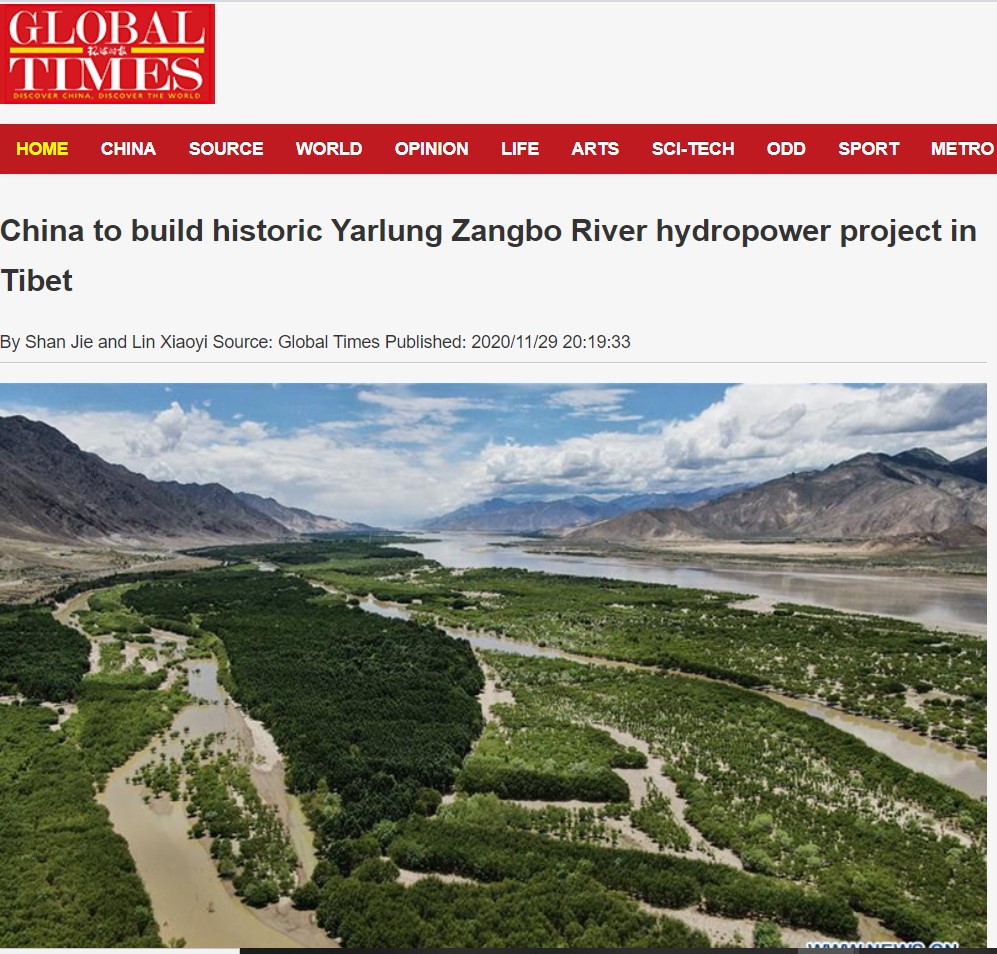
Yet the Global Times 29 November 2020 report that sparked panic was oddly coy about crucial details, such as where on a river 3000 kms long these new dams would be. Nor had Global Times done much actual journalism. It merely reprinted what was online, from an obscure meeting of China’s Hydroengineering professional association celebrating its 40th anniversary.
It got curiouser. Having stated key facts: new dam, definitely part of the 14th Five-Year Plan to be rolled out early 2021, definitely to be constructed by the state owned giant POWERCHINA (which refers to itself in Trumpian CAPITALS); the story then slid into vagueness. Suddenly the reader was somewhere in “downstream Yarlung Zangbo”, where it all gets much more exciting: on a stretch of river only 50 kms long the river drops by 2kms, such a gigantic amount of hydropower just waiting for the turbines to capture it. Suddenly the story was studded with alluring statistics of hydropotential, and more: it all heralds a regional win-win for not only China but downriver India and Bangladesh. Just like the dams China has built athwart the Za Chu/Lancang/Mekong that make downriver Cambodia, Lao and Thailand so happy.
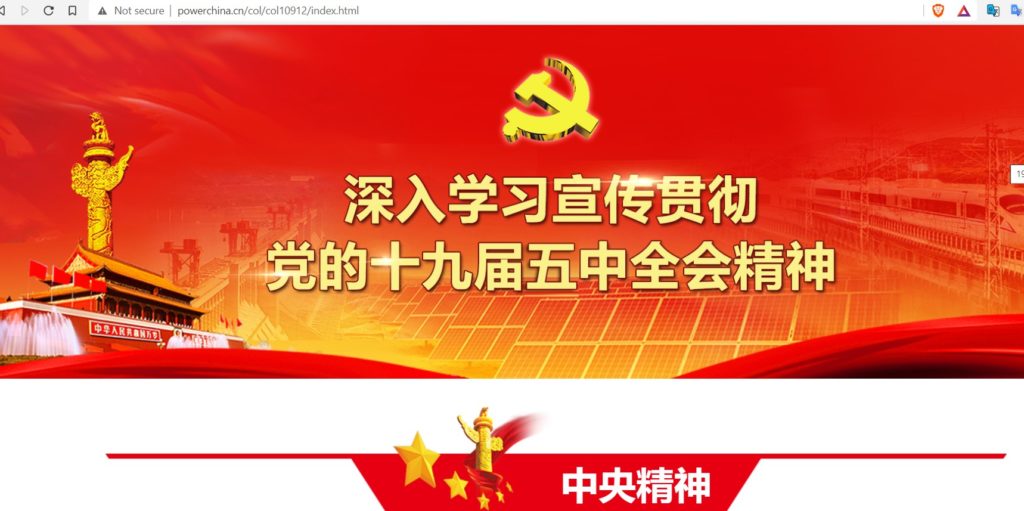
No, I’m not making this up, it’s all in the original story. Read it yourself. Just look out for the seamless slide from an actual dam, announced by your actual Xi Jinping, to all those potential dams way down in the deepest canyon in the world.
Throughout, it was clear the story originated with POWERCHINA, as the wet dream of its chairman Yan Zhiyong. But Global Times, ever the gleeful provocateur, made a meal of it.
What to make of this mishmash of actual projects approved for implementation in the 14th Plan, mixed in with the projections of POWERCHINA’s top projector Yan Zhiyong? And, crucially, where is the actual dam to be?
Global Times loves to make mischief. Of all the many media published by the Chinese Communist Party, it is the id, the freewheeling outlet for wolf warrior pugnacity. No doubt Global Times editors knew full well this report would trigger a fresh wave of panic and outrage in India, which happened fast. Timesnow and The Hindu quickly populated this initial post with dire warnings of floods and worse in India.
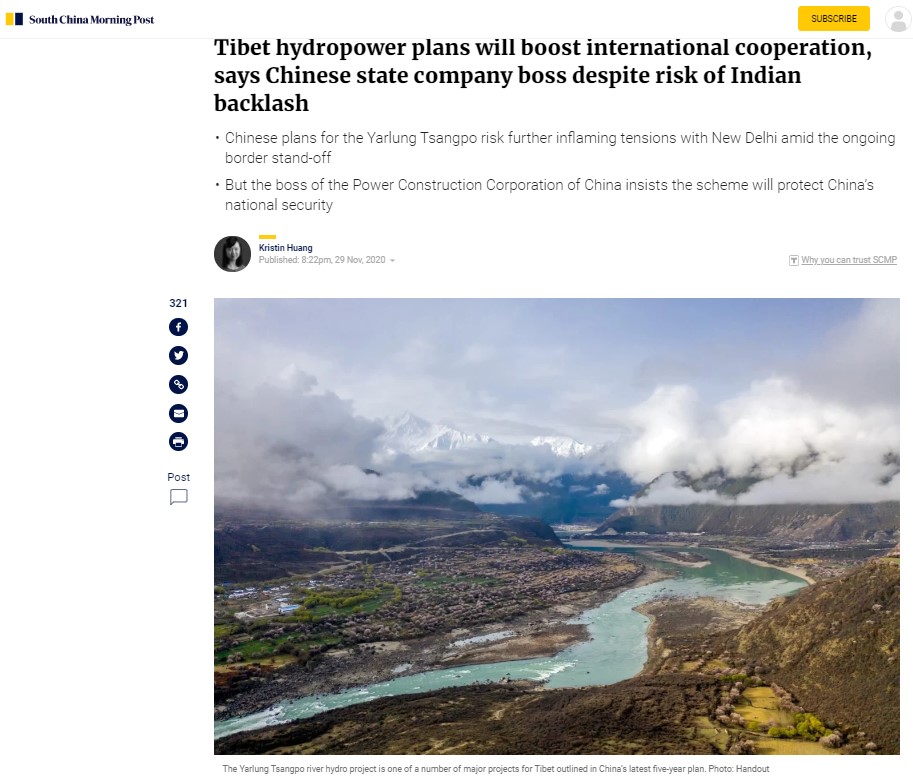
So was this conflation of an actual midriver dam plus fantasies of downriver megaproject speculation a deliberate attempt to annoy India, to trigger yet another neuralgic twinge of Indian nerves? In short, was this disinformation? Was it calculated to send Tibetans on a wild river raft ride to find dams that will probably never be built, way down in Metok land?
Alternatively, it may just be sloppy journalism, careless as to where facts blur into wishlists, specific plans waft off into speculation about an ideal hydroengineering utopia. In other words, was this misinformation?
Hard to be sure. Maybe we won’t get to an answer by starting from here. Better to start someplace else. Most journalists in Beijing, Delhi or Hong Kong know next to nothing about Tibet, the geography of its rivers, the depth of its canyons, the geomorphology of this collision of continents. It’s like reporting a far distant country, of which we know little, way over the horizon. For all of China’s talk that Tibet has always been part of China, nothing better illustrates how much it is in Chinese minds another country, than this chronic vagueness.
That suggests misinformation, lo-rent journalism so careless it doesn’t even notice the slide from fact to PR puffery by POWERCHINA trying to drum up business.
********************************************
So let’s backtrack and start someplace else. Here is what we do know.
The 14th Five-Year Plan for 2021 to 2025 is rapidly taking shape, in intensive debate within the Beijing elites. The dam approved for construction in the 14th Plan is in Nyingtri (Linzhi in Chinese), roughly 200 kms down the Yarlung Tsangpo from the cascade of dams built in recent years in Gyatsa. Of the five dams planned for the narrow valleys of Gyatsa only three have actually been built, with few signs yet of the other two.
Now, it seems, the dam builders have moved downriver, and for compelling reasons. All is revealed when you go to the website of POWERCHINA: http://www.powerchina.cn/art/2020/11/10/art_10914_905173.html
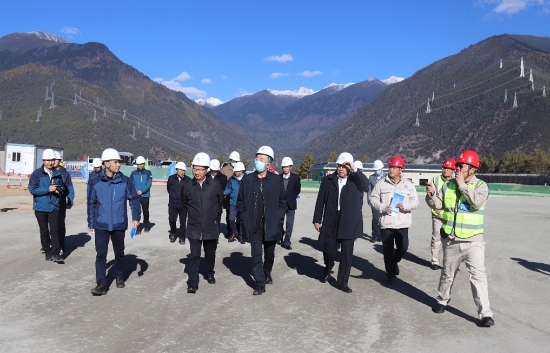
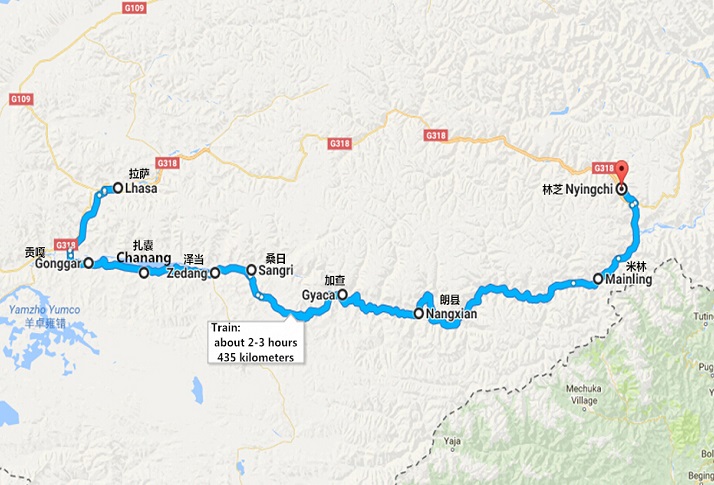
A HYDROPOWERED RAILWAY TO HEAVEN
The purpose of the Nyingtri hydropower dam is to power the electrified high-speed double track railway under construction between Lhasa and distant Chengdu, capital of Sichuan. This is made clear in POWERCHINA’s report of its chairman’s trip to Nyingtri only three weeks before Global Times got us all hot and bothered. The Chengdu-Lhasa railway is named four times in four sentences by POWERCHINA party boss and CEO Yan Zhiyong: “First, deeply study and understand the spirit of the Fifth Plenary Session of the 19th Central Committee of the Party and General Secretary Xi Jinping’s important instructions for the construction of the Sichuan-Tibet Railway to raise awareness of the extreme importance of participating in the construction of the Sichuan-Tibet Railway, the responsibilities and missions shouldered by them; second, the Party Central Committee must implement the slogan of “Build Tibet into a world ecological environment.” The requirements of “protected highlands”, pay attention to construction safety and environmental protection, and firmly establish the goal of participating in the construction of Sichuan-Tibet Railway to “lead the construction and strive for the first”; third, the contract must be strictly fulfilled, and the premise of ensuring safety, quality and green Plan, arrange, and organize carefully in advance to ensure that the project schedule is achieved ahead of schedule; fourth, it is necessary to make a good start and start well, with the main leaders directing ahead, integrating into the overall Sichuan-Tibet railway construction in an all-round way, strengthening refined management, and strict Management.”

Official media have pumped out stories regularly on the progress of this new railway, intended to reduce the overland time from Chengdu to Lhasa to only 13 hours. Story after story extolling the prowess of China’s engineers feature the bridges and tunnels designed to make this high-speed rail line possible. What has been until now a bit of a puzzle is where the electricity for an electrified line (unlike the single track Lanzhou to Xining to Gormo to Lhasa line of 2006) is to come from. Now we know.
Reliably electrifying such a long rail double track for high speed traffic is a major undertaking. Despite the innumerable tunnels and bridges, gradients are often steep, necessitating powerful electrical engines to haul uphill at speeds of up to 200 kmh in places, more likely an average of 130kmh.
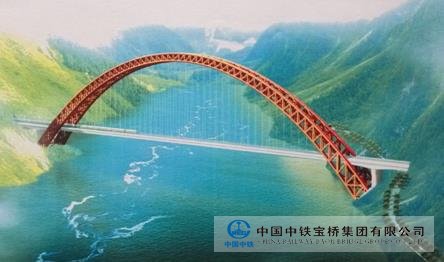
WHY NYINGTRI?
Nyingtri is the pivot, for several reasons. First, it is in its own right a destination being groomed as a major tourism attraction, notable for its early spring peach blossoms, promoted on mass media as China’s version of Japan’s obsession with cherry blossoms. What could be better in the family album than pix of your wedding under the peach blossoms of Nyingtri? You’d hardly know you were in Tibet, the climate is so mild and the air not too scarily thin. You might decide you are in the classic 23 centuries old Han fantasy peach blossom paradise, a utopian pure land where today’s new rich can now build luxury villas.
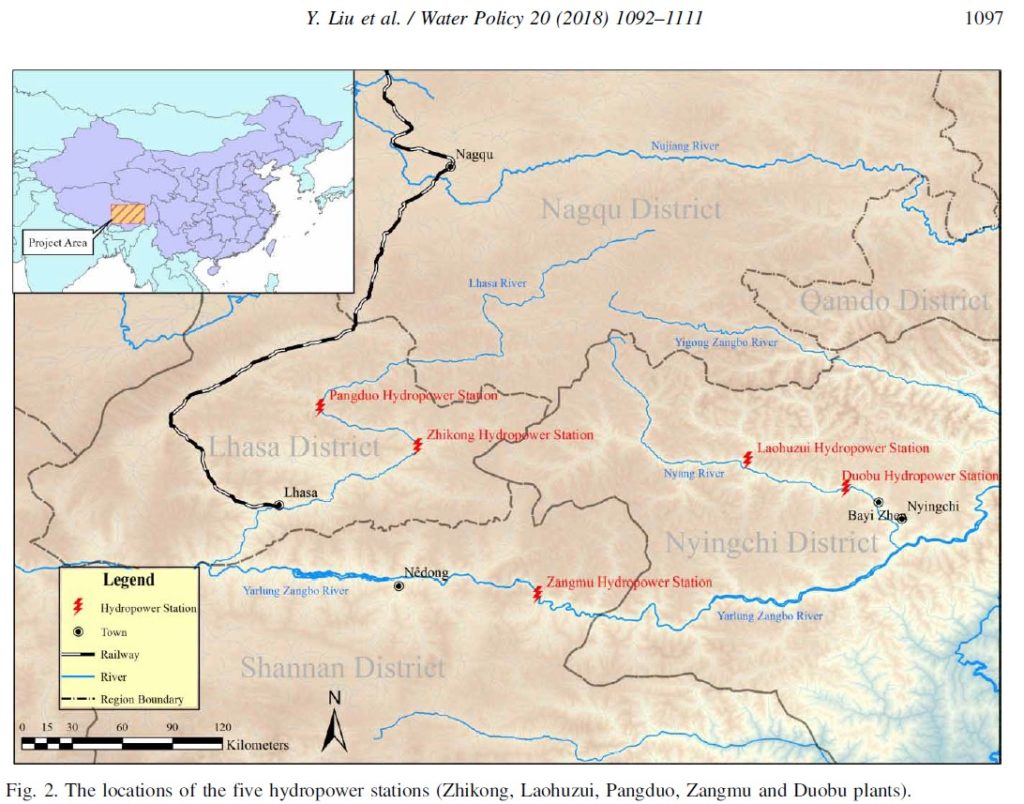
Nyingtri, so tantalisingly close to the Arunachal border, gets warm monsoonal winds from nearby India, and the altitude, low by Tibetan standards, makes for a mild climate, a respite from the heat and humidity of Chengdu. This positions Nyingtri as a hill station for the rich to retreat from the plains and entertain guests in their private villa, or in the Nyingtri Hilton. Nyingtri may soon be as overwhelmed by Han domestic tourists as Lhasa is, which struggles to manage 25 million arrivals a year.
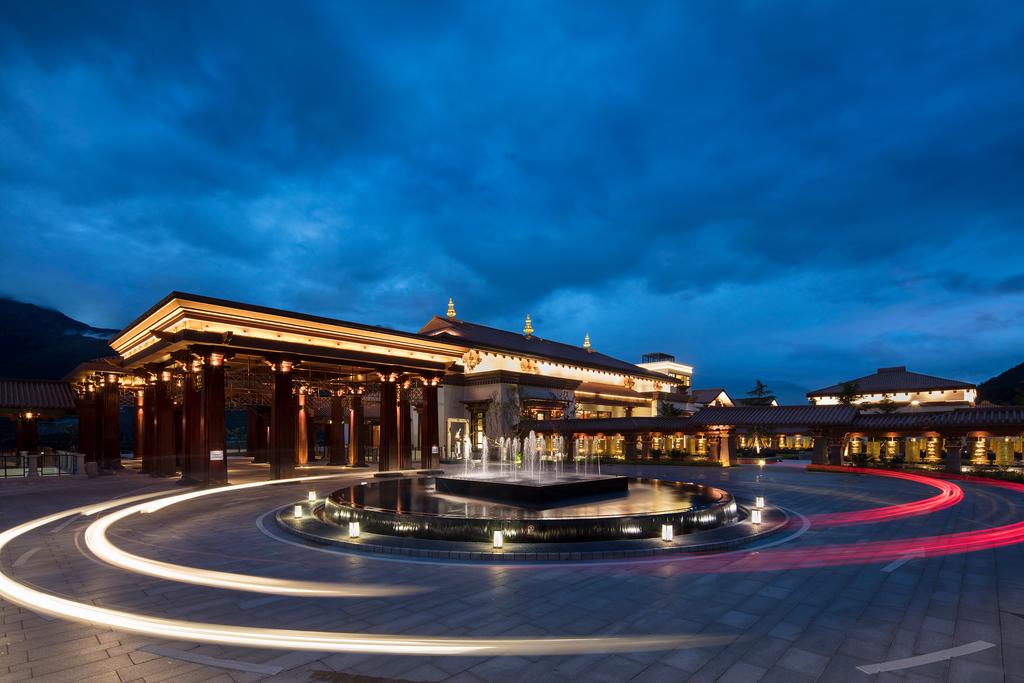
Second, Nyingtri, so close to India, is a staging ground for power projection southward, into what China persistently calls Southern Tibet, known to India as the state of Arunachal Pradesh. It is this proximity that causes such neuralgic pain of the powerful Indian security establishment.
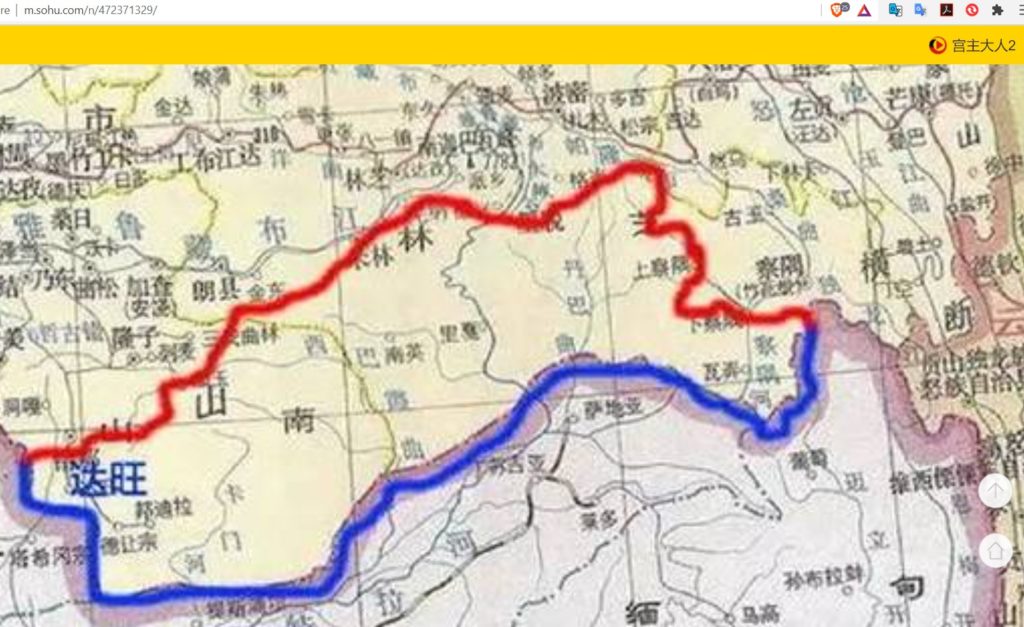
Third, the entire Lhasa-Chengdu railway project was designed to pivot round Nyingtri. Construction was spilt into two workforces, one doing the long uphill haul from Chengdu, through the precipitous landscapes of Kham all the way to Nyingtri; the other workforce doing the shorter Lhasa to Nyingtri section. Nyingtri and its Chinese twin city Bayi (meaning August first, commemorating the PLA foundation day) has become a logistics hub, a major base of China’s power and ultimately, in the hopes of the hydroengineers, gateway to the deepest of canyons further downriver, and the might of a raging wild mountain river cutting ever deeper as the Himalayas flanking either side rise ever higher. That is where POWERCHINA’s Yan Zhiyong would like to ideally build more dams, so many he would get into the record books, bigger than even the Three Gorges.

***********************************
Thus far, we have tracked the story causing the proliferating neuroses in India, finding the actual dam location in Nyingtri, nothing to do with the wild speculations of mega mega projects Global Times slides into further downriver. Maybe this all suggests misinfo rather than disinfo.
But there is one element of the Global Times story yet to explain. That’s the prospect of persuading India and Bangladesh that this is somehow a win-win for them too. Lin Boqiang, an energy economist in distant Xiamen is quoted at length: “Lin stressed that hydropower projects on cross-border rivers cannot be developed without communication and cooperation between upstream and downstream countries. The hydropower development of the Yarlung Zangbo River will provide more opportunities for cooperation between China and South Asian countries, which can learn from the mode of the Lancang-Mekong cooperation mechanism, through dialogue and establishment of cooperation mechanisms to promote the comprehensive utilization and development of water resources.”
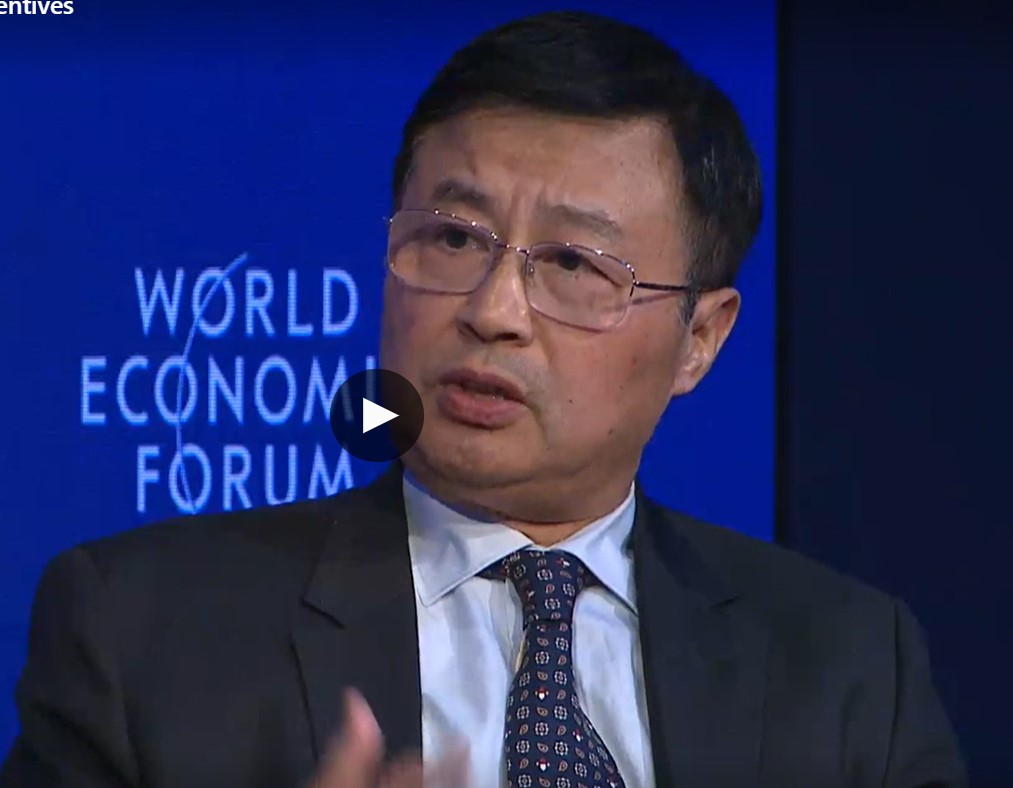
WHAT’S GOOD FOR ME IS GOOD FOR YOU
How exactly does that work? If China builds more and more hydro dams on the Yarlung Tsangpo/Brahmaputra no amount of win-win blather will persuade the lower riparians this is somehow beneficial for them too. They see clearly that China is playing the old game, played worldwide, of upper riparians dominating lower riparians, calling the shots. Yet Lin Boqiang repeatedly calls for cooperation (on China’s terms). Why?
China has long been adept at proposing the losers, in transacting with China, should be glad China gave them this opportunity, and Lin Boqiang is adept in arguing the ongoing validity of subsidising coal fired power.
Lin Boqiang is not your average energy economist. He sits on the board of China National Petroleum Corporation, and is listed by London Speaker Bureau as one of their star performers. Fluent in English, he pops up at A-list events such as the Davos World Economic Forum, alongside the architect of the 2015 Paris climate agreement, Christiana Figueres. She put him on the spot, (@ 20 mins in) with a pointed question about when China would stop its massive subsidies to coal mines and coal fired power stations. Lin Boqiang’s answer is a virtuoso performance of the ancient Chinese art of persuading you that what is good for me is also good for you too. It takes him minutes to get around to saying the subsidies should stay, slipped in so seamlessly that only someone as sharp as Christiana Figueres would pick it up. He is a silvertongue virtuoso, worth watching. An heir to Zhou En-lai.
So this is classic Global Times disinformation. First comes a hook: a new dam somewhere unnamed on the Yarlung Tsangpo. Second: touting massively more dams further downriver; third a rationale for why this is a win-win for all concerned. All the segues stitched seamlessly.

REAL WORLD REALITIES
Among the many basic facts not mentioned in this Global Times provocation is an engineering reality of deep canyon damming: the only way to get the massive turbines into place, just below any dam that interrupts the Yarlung Tsangpo as it rages through its’ lower gorges, would be to float them upstream, up through Bangladesh and India, on heavy duty barges. Engineers established that decades ago. There is just no way of getting a delicate turbine weighing over 400 tons into place by parking a crane over a precipice and lowering it five kilometres into the wildest of rivers.
Maybe this is what Global Times is hinting at, by suggesting India and Bangladesh gotta love it too?
If only India knew this, they could relax, knowing they hold the ace. For once, the lower riparians have power over the uppers.
So, all in all, Xi Jinping has definitely ordered a hydrodam be built in the 14th Plan period at Nyingtri, and POWERCHINA is the builder, and is in a hurry, as the railway is nearing completion. That is what we do know.

FIND THAT DAM
Exactly where is this 14th Plan dam? How long will it take to build? Given the seasonal extremes of Yarlung Tsangpo flow, how big will it have to be to impound enough water to generate electricity throughout the year? Will it be big enough to not only power the railway but also make the Bayi-Nyingtri twin city a major city for Han settlers, especially the rich, in their luxe villas? So much we don’t yet know.

Is it even on the Yarlung Tsangpo, or on the Nyang River ཉང་ཆུ, 尼洋曲 which flows into the Yarlung Tsangpo? It is on the Nyang Chu that the present hydro power for Nyingtri comes from, the modest Duobu dam. That dam cost Beijing RMB 1.2 billion to build.[1] Installed electricity generating capacity is 120 megawatts, modest compared to many of the hydro dams in Amdo on the Ma Chu/Yellow River.[2] With construction under way, part of the 12th Five-Year Plan, Chinese hydro engineers discovered in 2013 they had a big problem. Thick layers of sediment, gravel and sand, had built up on the Nyang Chu, yet a huge chamber had to be excavated in this porous, loose sediment to house the underground turbines that generate the electricity. In any hydro power setup, the turbines have to be well below the dam, so the impounded water can rush down, gather speed, and so spin the turbines. How to dewater an underwater and under sediment space when groundwater pours in on all sides? The klu spirits of the waters weren’t going to yield their domain so easily. The chosen site was far from ideal. Eventually, deep wells had to be drilled, far below the turbine chamber site, using a lot of electricity to pump out the constantly accumulating water.[3]
The Duobu dam is well above both Nyingtri and its Chinese twin Bayi (Gyechik Drong in Tibetan), and 60kms above the junction of the Nyang and the Yarlung Tsangpo. The Nyang Chu is a longish river, with another hydropower station further above, called in Chinese Laohuzui, a further 70kms further upriver. Since the Duobu site was so tricky, maybe this new dam will be near Laohuzui?
But constructing Laohuzui was highly problematic too. Two tunnels had to be blasted through hard rock, the first a diversion tunnel to drain the riverbed for the dam to built on it, the second a spillway tunnel. The blasting caused the steeply sloping rockface above the tunnels to collapse.[4] According to the engineers, the rock turned plastic. Those shape shifting gods are tricky.
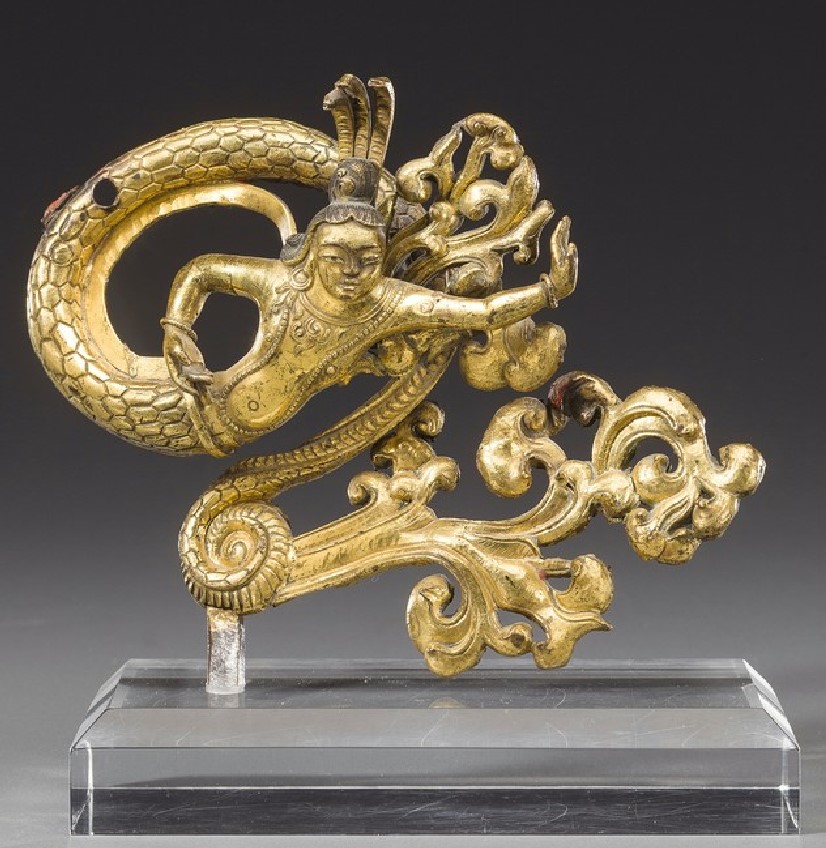
These problems have been much debated in recent years.[5] Despite the slippery fluidity of Tibetan water and unreliable rockiness of Tibetan rock, Xi Jinping has decreed that part of the 14th Five-Year Plan is a new hydro dam, somewhere in the Nyingtri district, to speed high-speed rail on its way to Lhasa. Oddly, Global Times told us none of this. But then, for Global Times, your actual Tibet is so far away, another country really.
[1] Yue Liua et al, Competitiveness of hydropower price and preferential policies for hydropower development in Tibet and the Sichuan-Yunnan Tibetan area of China, Water Policy, 20 (2018) 1092–1111
[2] Qi Xia Liu et al, Comparing and Selecting the Dewatering Schemes of Tibet Linzhi Duobu Hydropower Station Underground Factory Buildings, Advanced Materials Research, 3237-3243, 2013
[3] Qi Xia Liu et al 2013
[4] Hongkai Dong, Fei Ye & Wenxi Fu (2019) Stability reliability of a cutting slope in Laohuzui Hydropower Station in Tibet of China, Geomatics, Natural Hazards and Risk, 10:1, 935-957,
[5] Chen Jian Wang Quancai Zhang Qunli Li Bo Guo Jiang., Application analysis of new prevention structure for large-scale collapse in Laohuzui, Science Technology and Engineering, 2015, 35 (31): 79-84
Liu Weiluo Hongying Yu Qiang Yuan Jinhui, Numerical Simulation Research on Internal Flow Field of Turbine of Tibet Laohuzui Power Station, China Water Resources, 2015, (18): 59-62
Zhu Bin, Wei Yufeng, Fu Wenxi. Study on slope stability of right abutment of Laohuzui Hydropower Station, Journal of Geological Hazards and Environment Preservation, 2017, (01): 49-53
Yang Huabin/ Hua-Bin Yang, Application of Prestressed Anchor Construction Technique in High Slope Stabilization at Laohuzui Hydropower Station in Lingzhi of Tibet: Sichuan Water Power, Vol. 29 Issue 1,p25-29+32.
Cao Yue/ Yue Cao; Yang Huabin/ Hua-Bin Yang, Application of Controlled Cement Grouting to anti-seepage of Cofferdam for Construction of Laohuzui Hydropower Station, Water Resources and Hydropower Engineering. Vol. 39 Issue 7, p55-57
Mu Yu, Construction of Impervious Wall of Deep Overburden of Laohuzui Hydropower Station in Tibet, Shanxi Architecture, 2015, 41 (13): 76-77